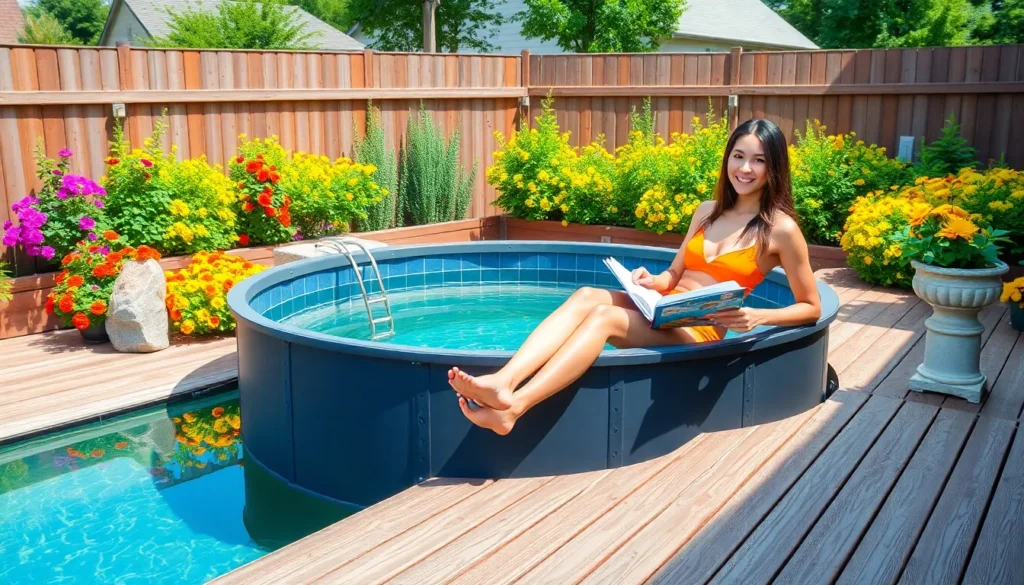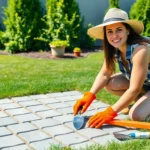We’ve all dreamed of having a backyard pool but balked at the massive price tag and lengthy installation process. That’s where stock tank pools come in – they’re transforming backyards across America with their affordable charm and surprisingly quick setup.
Stock tank pools aren’t just trendy; they’re practical answers that deliver real swimming enjoyment without very costly. These galvanized steel beauties cost a fraction of traditional pools while offering the same refreshing escape from summer heat. We’re talking about pools you can install in a weekend rather than waiting months for construction crews.
The best part? Stock tank pools offer endless customization possibilities that’ll make your neighbors seriously envious. From rustic farmhouse vibes to sleek modern designs we’ll show you how to create the perfect backyard oasis that matches your style and budget.
Choose the Right Size Stock Tank for Your Space
Selecting the perfect stock tank pool dimensions sets the foundation for your backyard transformation success. We’ll guide you through the essential measurements and considerations that ensure your new pool fits seamlessly into your outdoor space.
Measure Your Available Area
Calculate your yard’s dimensions before browsing stock tank options to avoid costly sizing mistakes. Most homeowners need at least 2-3 feet of clearance around the entire perimeter for maintenance access and safety.
Record both length and width measurements of your intended pool location, including any overhead obstacles like tree branches or power lines. Standard stock tank pools range from 6 feet to 11 feet in diameter, with 8-foot models being the most popular choice for average backyards.
Mark the proposed area using spray paint or rope to visualize how the pool will impact your existing industry and outdoor furniture placement. This step reveals potential issues with sprinkler systems, underground utilities, or property line restrictions that could affect your installation.
Consider Pool Depth Options
Stock tank pools typically offer depths between 18 inches and 24 inches, which provides comfortable standing water for most adults while remaining safe for children with supervision.
Deeper tanks around 24 inches work best for adults who want to sit comfortably on the pool floor or prefer more water volume for temperature regulation during hot weather.
Shallower 18-inch options suit families with small children or homeowners who prioritize easier entry and exit over maximum water depth. These models also require less water to fill and weigh significantly less when full.
Factor in Weight and Foundation Requirements
A filled 8-foot stock tank pool weighs approximately 5,000 pounds, requiring a solid, level foundation to prevent settling or structural damage to your yard.
Compact gravel bases work effectively for most installations, typically requiring 4-6 inches of compacted material extending 12 inches beyond the tank’s perimeter. Sand alone doesn’t provide adequate support for larger tanks.
Consider professional foundation installation for tanks larger than 8 feet or if your yard has important slope issues. The weight distribution becomes critical as pool sizes increase, and improper foundations can lead to expensive repairs or safety hazards.
| Tank Size | Water Capacity | Total Weight When Full | Recommended Foundation |
|---|---|---|---|
| 6 feet | 390 gallons | 3,200 lbs | 4″ compacted gravel |
| 8 feet | 650 gallons | 5,400 lbs | 6″ compacted gravel |
| 10 feet | 1,100 gallons | 9,200 lbs | Professional installation |
| 11 feet | 1,300 gallons | 10,800 lbs | Concrete pad recommended |
Create a Stunning Deck Surround
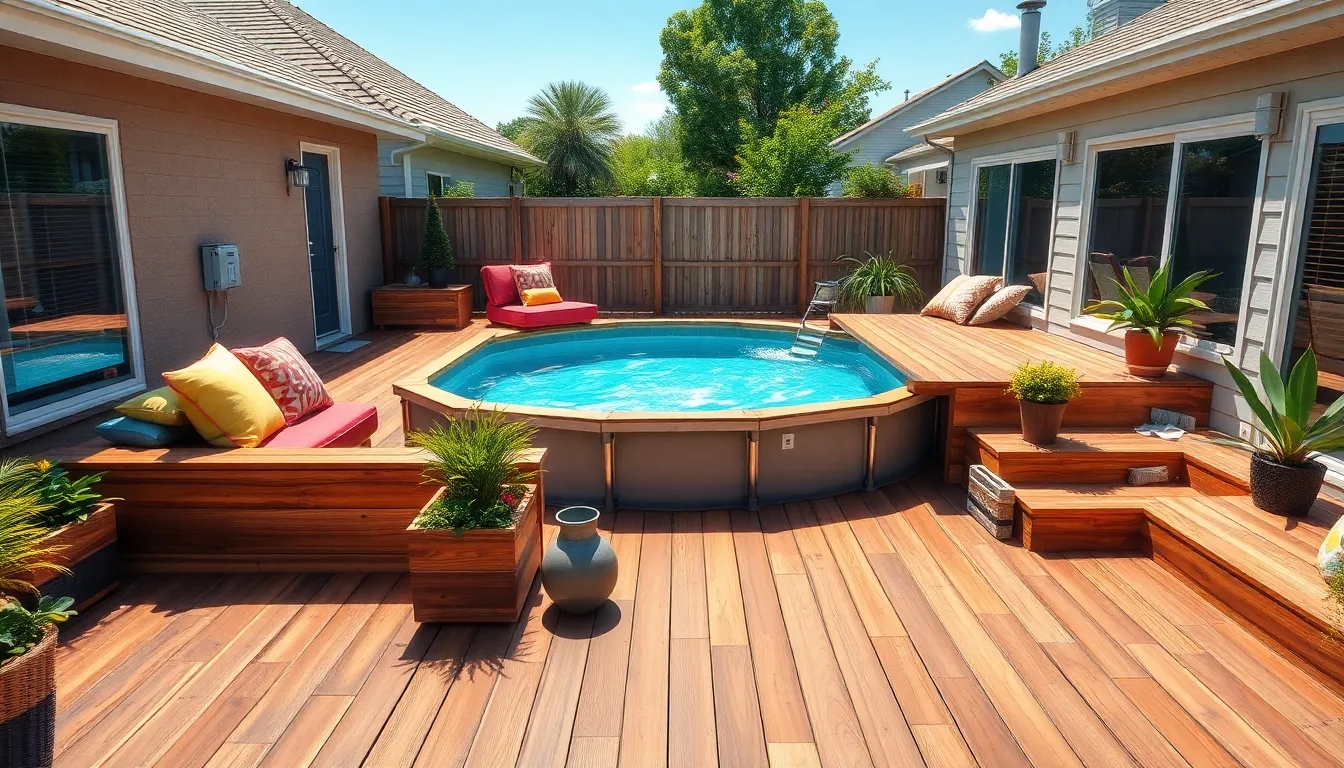
Building a custom deck around your stock tank pool transforms a simple above-ground pool into an integrated backyard feature. We’ll explore three popular approaches that enhance both functionality and visual appeal while maximizing your outdoor space.
Build a Wooden Platform Deck
Wooden platform decks offer the most customizable solution for creating an 8-foot pool deck surround. Construction typically starts with concrete pier blocks as your foundation base, supporting the entire structure with stability. Treated 4×4 posts provide vertical support, while weather-resistant treated lumber forms the decking surface that withstands moisture and UV exposure.
Flexibility becomes the key advantage when building wooden platforms around stock tank pools. You can customize deck size to match your exact pool dimensions, position stairs for optimal access, and incorporate special features like secret hatches for pump and filter maintenance. Weather-resistant treated lumber ensures longevity while creating that warm, natural aesthetic that complements most backyard designs.
Building costs remain relatively affordable compared to permanent pool installations. Most DIY enthusiasts can complete a wooden platform deck project over a weekend using basic construction tools and lumber from local home improvement stores.
Install Composite Decking Materials
Composite decking materials provide superior durability and low maintenance compared to traditional wood options. These engineered materials resist water damage, rot, and fading that typically affect wooden decks around pool areas. Installation follows similar techniques to wood decking but requires exact fasteners designed for composite materials.
Maintenance requirements drop significantly with composite materials, eliminating annual staining or sealing tasks. You’ll spend more time enjoying your stock tank pool and less time maintaining the surrounding deck structure. Modern composite options come in various colors and textures that mimic natural wood while providing enhanced performance.
Cost considerations show composite materials require higher upfront investment but deliver long-term savings through reduced maintenance needs. The extended lifespan and consistent appearance make composite decking an excellent choice for homeowners seeking a modern, clean look around their pool area.
Add Built-in Seating Areas
Built-in seating maximizes functionality by incorporating comfortable lounging spots directly into your deck design. Custom benches can wrap around the pool perimeter, providing multiple seating options without requiring additional furniture that takes up space. These integrated features often combine seating with storage compartments for pool accessories, towels, or outdoor cushions.
Design flexibility allows you to paint or stain built-in seating to match your existing deck finish. Adding weather-resistant cushions or outdoor pillows enhances comfort while introducing color and style elements that reflect your personal taste. Some creative designs incorporate plant holders into seating structures, creating natural greenery around your pool area.
Construction techniques for built-in seating follow standard carpentry principles using the same materials as your main deck. Planning seating height at standard 18-inch bench dimensions ensures comfortable use for adults and children alike, while considering back support options for extended relaxation periods.
Install Proper Filtration and Circulation Systems
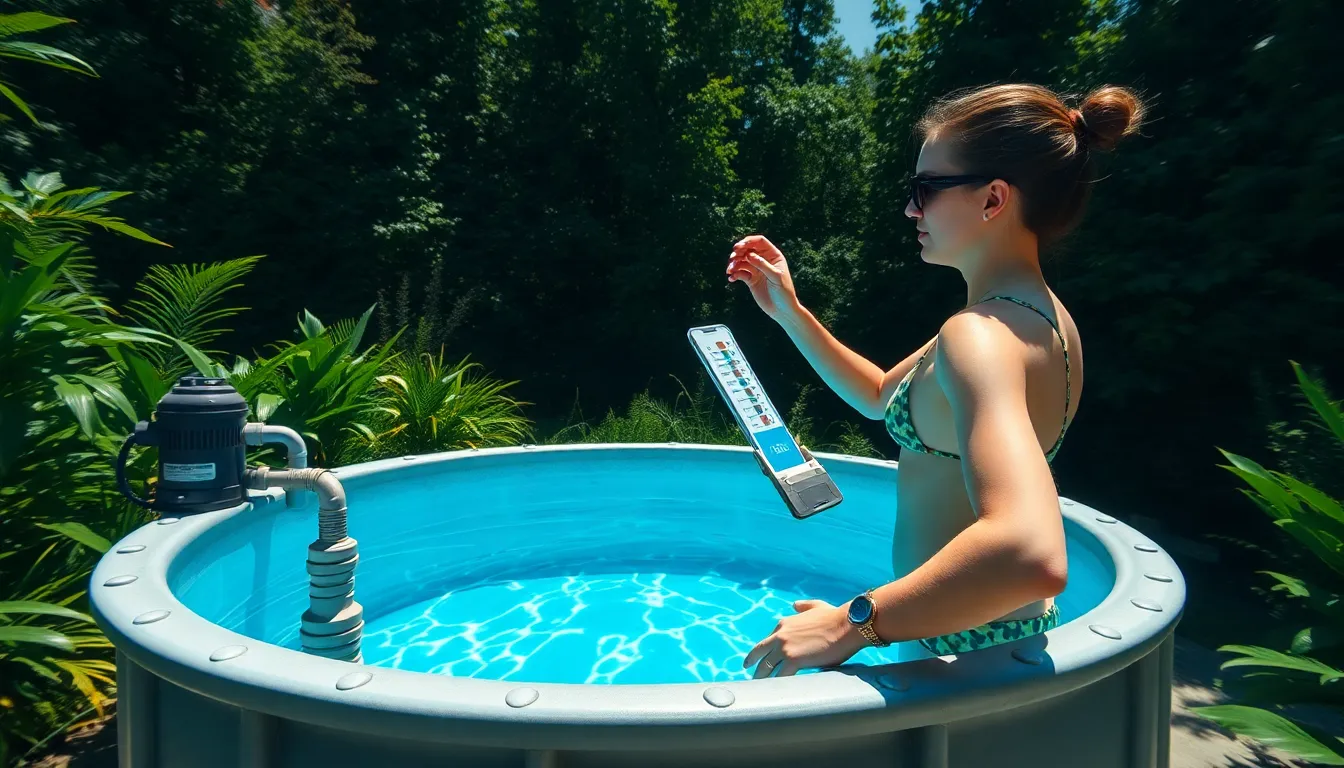
Water circulation keeps your stock tank pool clean and prevents stagnation that leads to algae growth. We’ll cover the essential components needed to maintain crystal clear water throughout the swimming season.
Select Appropriate Pool Pumps
Choosing the right pump ensures adequate water movement without excessive energy costs or noise. Intex filter pumps work exceptionally well for stock tank pools due to their affordability and proven effectiveness. Match your pump size to your tank dimensions to provide sufficient water turnover without overworking the system.
Run your pool pump 4 to 6 hours daily based on water conditions and usage levels. Set valves and pump controls properly before operation to prevent equipment damage and maximize filtration efficiency. Installation guides and instructional videos are readily available to help you set up your system correctly.
Add Effective Filtration Equipment
Filters trap debris and maintain water clarity by removing particles that cloud your pool water. Clean your filters regularly by hosing them off or soaking them overnight in a specialized filter cleaner solution. Replace dirty filters promptly to maintain optimal filtration performance.
Mechanical filtration works alongside chemical sanitation to keep your water safe and clean. Add chlorine tablets and pool shock to control bacteria and algae buildup effectively. Skim the water surface daily to remove floating leaves, insects, and other debris before they sink to the bottom.
Maintain Water Quality Standards
Testing water chemistry regularly ensures safe swimming conditions for your family and guests. Use a reliable water testing kit to monitor pH levels between 7.2 and 7.6, with alkalinity maintained at 80 to 120 ppm. Add chlorine or other sanitizers consistently to prevent harmful bacteria and algae from taking hold.
Cover your pool when not in use to reduce debris contamination and minimize water evaporation. Scrub pool walls and the bottom surface routinely to prevent algae buildup and eliminate slippery surfaces. These maintenance practices extend your pool’s lifespan while ensuring comfortable swimming conditions all season long.
Design Eye-Catching Landscaping Around Your Pool
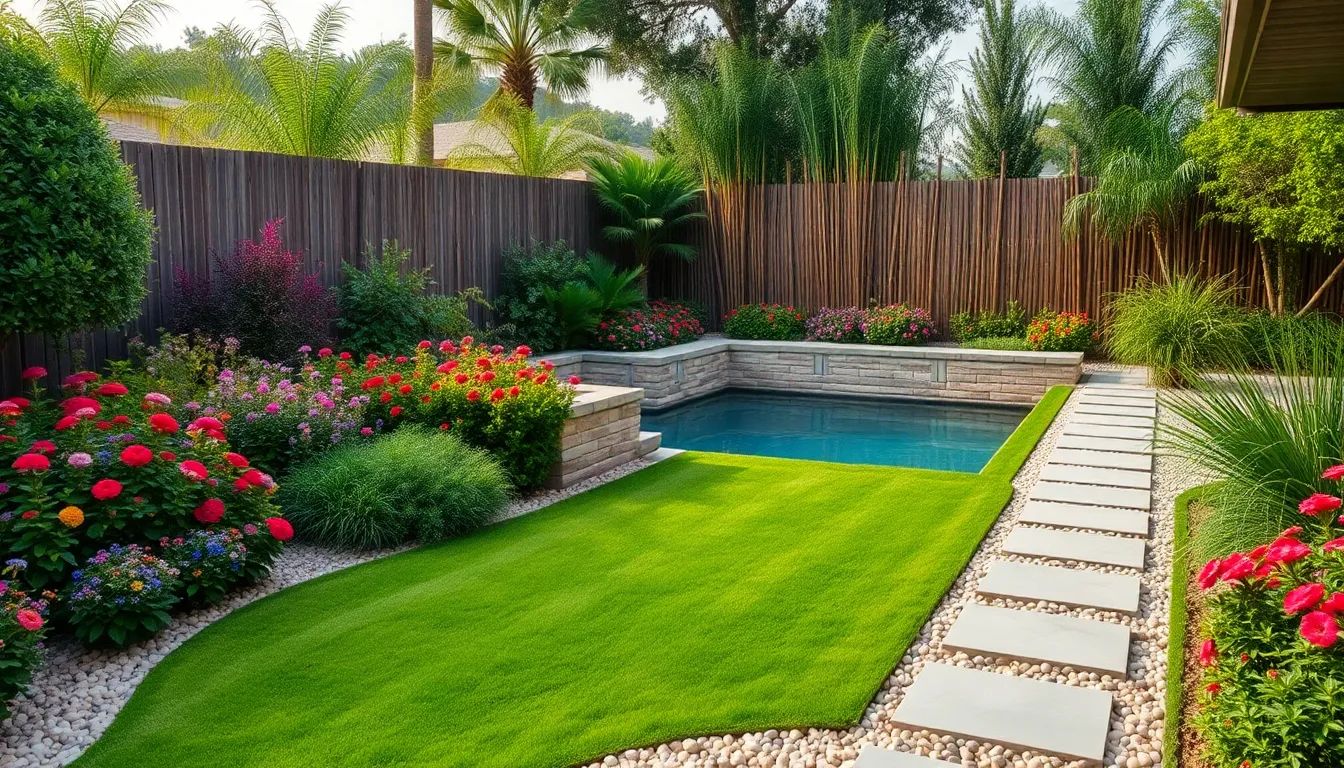
Creating a stunning industry around your stock tank pool transforms it from a simple water feature into a backyard oasis. We’ll show you how to elevate your pool area with strategic plantings and decorative elements that integrate seamlessly with your outdoor space.
Plant Strategic Greenery and Shrubs
Strategic placement of plants creates visual interest while making your stock tank pool feel naturally integrated into your yard. For compact spaces, we recommend surrounding an oval-shaped stock tank pool with flower bushes to save space while adding special character to the area.
Oversized plants like bamboo or large potted specimens add a boho or tropical vibe that complements the casual nature of stock tank pools. Choose plants that thrive in your exact climate and complement your existing yard style. Consider using a variety of heights and textures to create depth and visual layers around the pool perimeter.
Create Natural Privacy Screens
Privacy screens made from living plants offer both functionality and beauty around your stock tank pool area. Dense shrubs planted strategically around the pool perimeter block sightlines from neighbors while adding lush greenery that softens the industrial look of the tank.
Bamboo walls work exceptionally well as natural privacy barriers, growing quickly to create an enclosed, resort-like atmosphere. These living screens provide year-round privacy while contributing to the overall aesthetic appeal of your pool installation.
Incorporate Decorative Stone Features
Decorative stones add texture and practical functionality to your stock tank pool industry design. Pebbled gravel works beautifully as ground cover, especially when combined with neatly arranged patio stones that create clean lines and visual interest around the pool area.
Gravel paths leading from your house to the pool provide an attractive and practical surface for wet feet. Carefully placed paver stones serve multiple purposes as bases for potted plants or comfortable seating areas, improving the overall design while maintaining functionality throughout your pool industry.
Add Functional Pool Accessories and Features
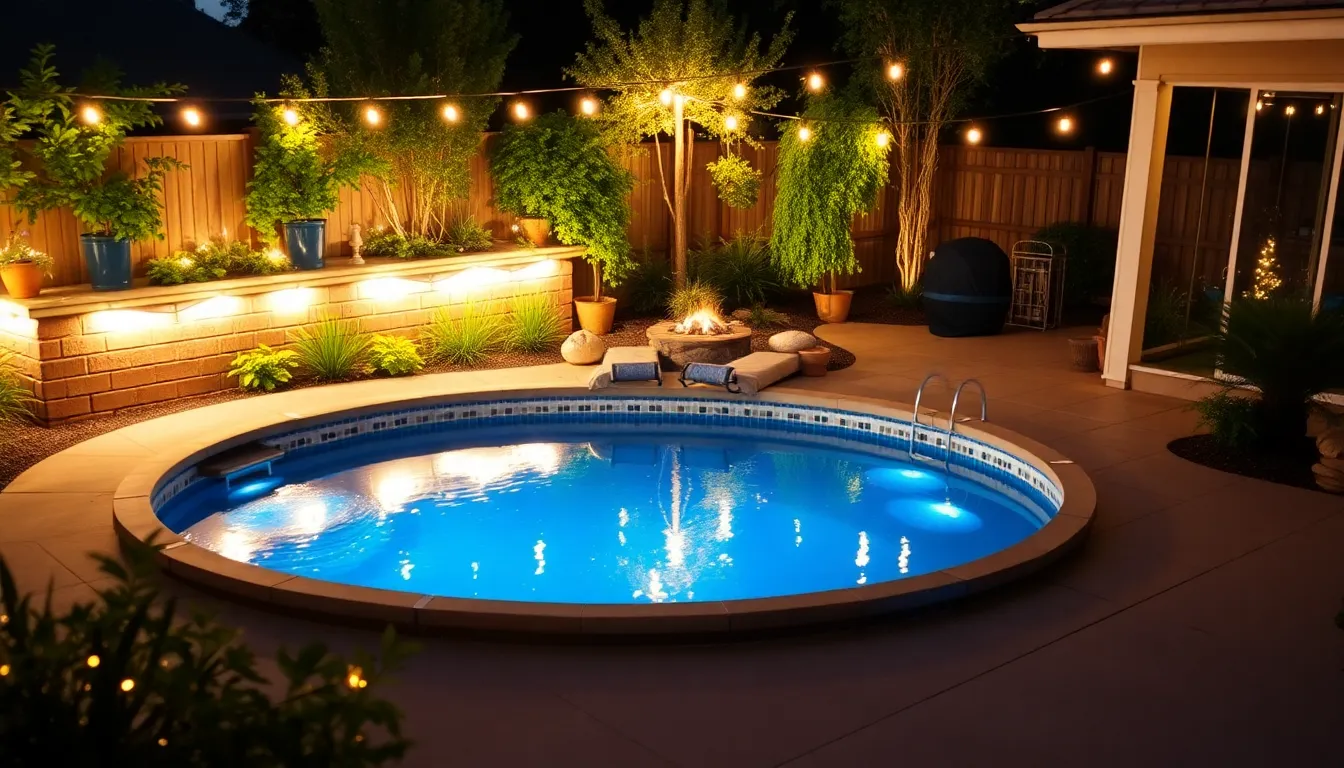
Smart accessories transform your basic stock tank into a fully functional backyard retreat. We’ll explore essential features that enhance both safety and enjoyment.
Install Pool Lighting Options
String lights create the perfect ambiance for evening swims while providing essential visibility around your pool area. We recommend waterproof LED string lights that can be mounted on nearby structures or wrapped around pool accessories for maximum effect.
Underwater LED lights offer a stunning visual element that transforms your stock tank into an illuminated centerpiece after dark. These waterproof lighting systems can be easily installed and provide both safety benefits and dramatic aesthetic appeal.
Integrated deck lighting serves a dual purpose by improving nighttime safety while creating a warm, welcoming atmosphere. Position these lights strategically around your decking area to eliminate shadows and highlight entry points.
Solar powered options reduce electricity costs while providing reliable illumination throughout the evening hours. Many solar lights automatically turn on at dusk and provide 6 to 8 hours of continuous lighting on a full charge.
Include Steps and Entry Points
Dual sided steps make entry and exit safer for swimmers of all ages and abilities. We suggest installing steps that reach the rim height of your stock tank, typically 2 to 3 feet, with non slip surfaces for added security.
Integrated deck access creates the most seamless entry experience when you build your pool partially into an existing deck structure. This approach eliminates the need for separate steps while providing a stable, comfortable surface around the entire pool perimeter.
Removable ladder systems offer flexibility for smaller spaces where permanent steps might create obstacles. These lightweight aluminum or resin ladders can be easily stored when not in use while providing secure access during swimming sessions.
Built in platforms extend your usable space while creating natural entry points at various heights. Consider adding a small platform at mid height for easier access, especially helpful for children or those with mobility concerns.
Add Pool Covers and Safety Equipment
Debris covers keep leaves, insects, and other unwanted materials out of your water while reducing cleaning time and chemical usage. We recommend fitted covers that secure tightly around the rim to prevent wind displacement and maximize protection.
Safety covers provide essential protection against accidental falls when the pool isn’t in use, particularly important for households with children or pets. Look for covers rated to support at least 485 pounds per square foot for maximum safety assurance.
Rim padding transforms sharp metal edges into comfortable, safe surfaces using foam pool noodles or specialized cushioning materials. This simple addition prevents cuts and bruises while making poolside lounging more comfortable.
Emergency equipment should include a reaching pole, life ring, and first aid kit positioned within easy access of your swimming area. Store these items in a weatherproof container nearby to ensure they remain functional when needed.
Pool alarms detect unexpected water movement and alert you to potential safety issues, providing an extra layer of protection for your backyard setup. Modern wireless systems can send notifications directly to your smartphone for immediate awareness.
Customize Your Stock Tank with Creative Finishes
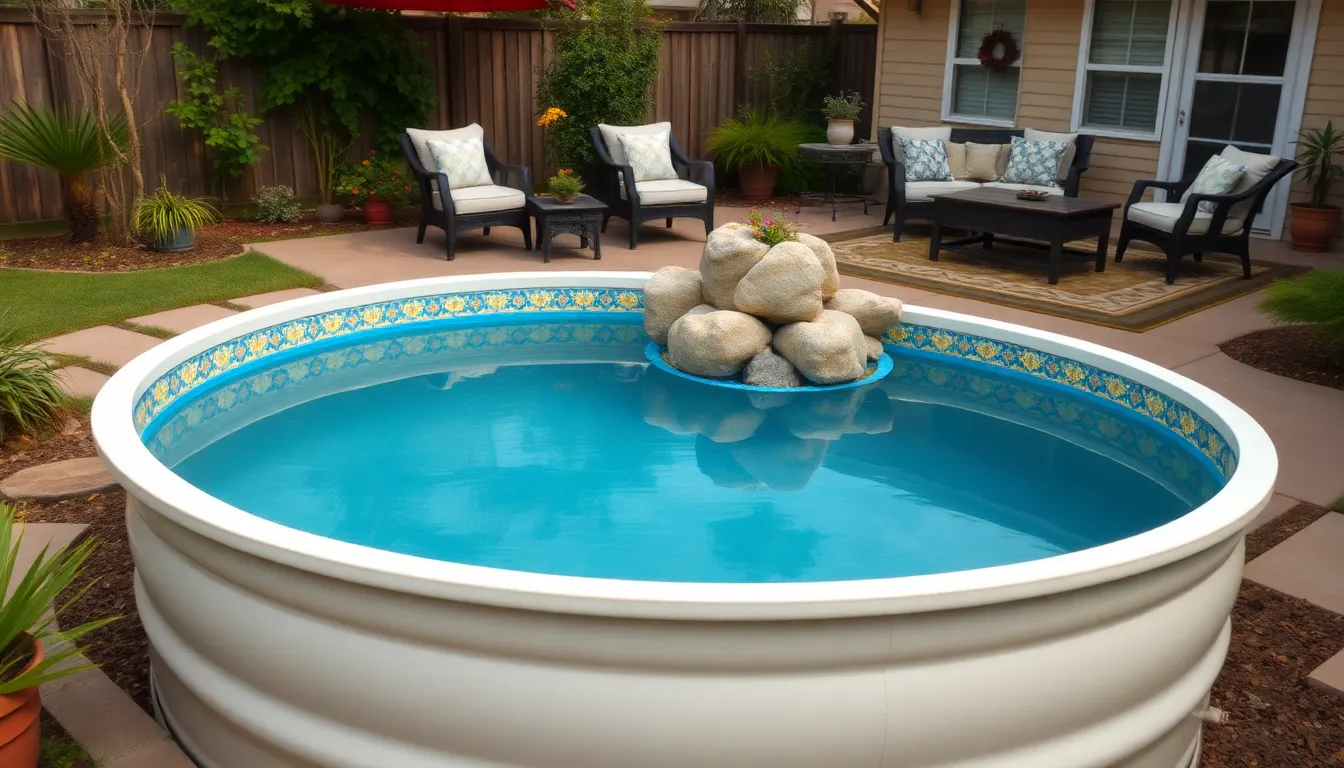
Transforming your stock tank pool from a simple galvanized tub into a stunning backyard centerpiece requires thoughtful finishing touches. We’ll explore three essential customization approaches that protect your investment while creating a personalized aesthetic.
Apply Protective Pool Coatings
Protective coatings form the foundation of any successful stock tank pool customization. These specialized finishes prevent rust formation and extend your pool’s lifespan significantly. Pool paints designed specifically for galvanized steel offer the best water resistance and durability for metal tanks.
Quality sealants create a waterproof barrier that protects against corrosion. Choose products that can withstand constant water exposure and temperature fluctuations. Marine-grade primers work exceptionally well as base coats before applying your final finish.
Proper surface preparation ensures coating adhesion and longevity. Clean the tank thoroughly with degreasing agents and lightly sand glossy surfaces. Allow complete drying before applying any protective products to achieve professional results.
Add Decorative Tile or Mosaic Accents
Tile accents along the pool edge instantly elevate your stock tank’s appearance. Installing decorative tiles around the rim creates a sophisticated border that mimics traditional pool designs. Waterproof adhesives and grouts ensure these accents withstand constant moisture exposure.
Mosaic patterns inside the tank add artistic flair and visual depth. Small glass tiles in blues and greens create an ocean-like effect that enhances the swimming experience. Consider using slip-resistant tiles for safety on pool floors and entry areas.
Strategic placement maximizes visual impact while maintaining functionality. Focus tile work on highly visible areas like the waterline and rim edges. Leave smooth surfaces for comfortable seating and easy cleaning access.
Paint Custom Colors and Patterns
Bold colors transform ordinary stock tanks into vibrant backyard features. Bright orange tanks bring energy to neutral landscapes while earth tones blend seamlessly with natural surroundings. Choose colors that complement your existing outdoor decor and personal style preferences.
Striped patterns add visual interest and personality to plain surfaces. Brown and white stripes create a classic nautical theme that coordinates beautifully with wooden deck spaces. Alternating colors break up large surface areas and make smaller tanks appear more substantial.
Stenciled designs provide endless customization possibilities. Apply geometric patterns geometric patterns, nautical themes, or seasonal motifs using marine-grade stencils. Refresh your design periodically by painting over previous patterns with new colors or themes to keep your pool area looking current.
Incorporate Heating Solutions for Year-Round Use
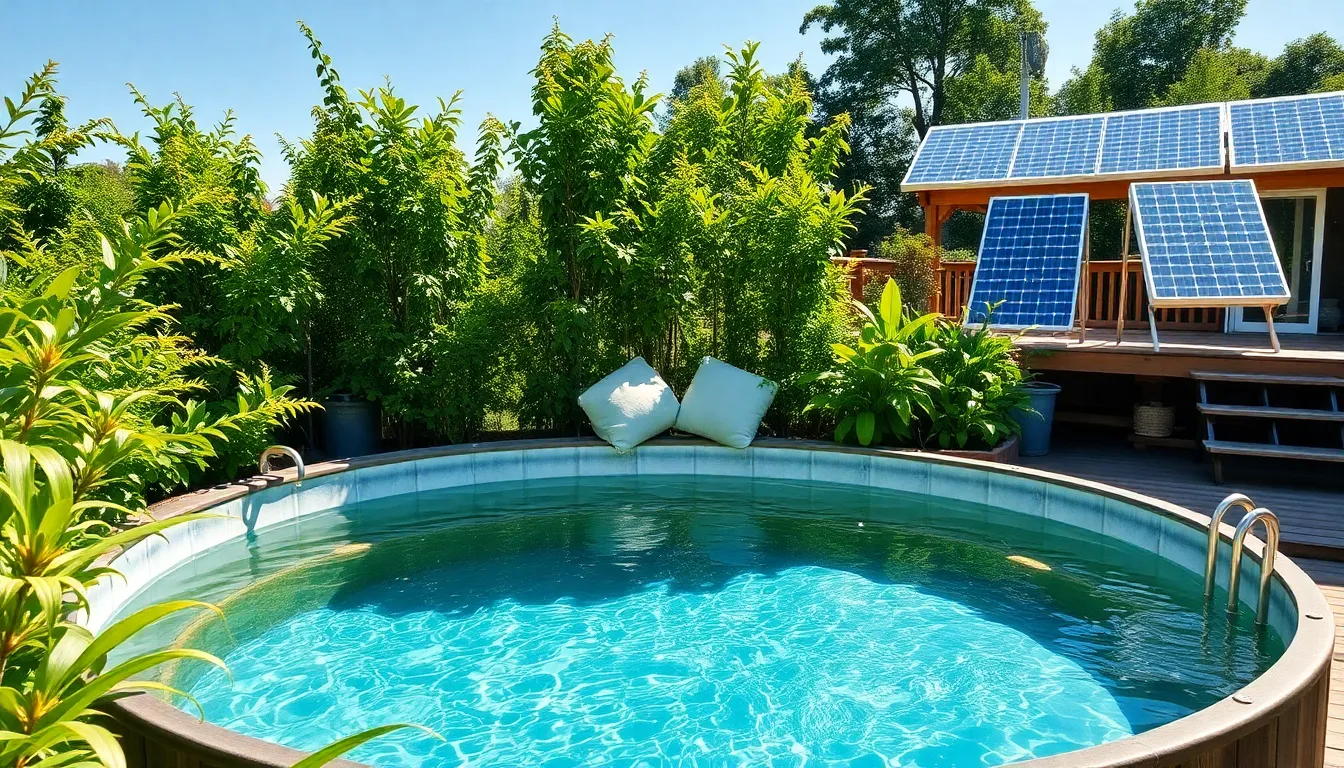
We can transform our stock tank pool from a seasonal splash zone into a year-round relaxation haven with the right heating answers. Here’s how we can keep the water warm and comfortable throughout all seasons.
Install Solar Heating Systems
Solar heating systems offer an eco-friendly approach to warming our stock tank pool by capturing and transferring heat from the sun directly to the water. We’ll find solar panels or solar pool heaters provide excellent supplemental heating to extend our swimming season without the ongoing energy costs of traditional methods.
Installation costs remain moderate compared to other systems, and we’ll see important savings on energy bills over time. We can position solar panels to maximize sun exposure and connect them to our existing circulation system for optimal heat transfer.
Best results come from sunny regions where we have consistent daylight hours. We should consider solar heating as our primary choice for supplemental warmth rather than a standalone solution for year-round use.
Add Electric Pool Heaters
Electric heaters deliver consistent and controllable heat that’s perfect for maintaining warm water temperatures throughout the year. We can choose from spa heaters or pool heater models that integrate easily with our existing electrical setup.
Installation becomes straightforward when we already have electricity available near our pool area. DIY enthusiasts have successfully rigged electric heaters to warm 8-foot tanks to hot tub temperatures for comfortable soaking.
Pre-designed electric heating systems like the “TANKUZZI” provide customized answers specifically for stock tanks at around $2,000. These systems offer reliable heating that lets us enjoy our pool comfortably even during chillier months.
We’ll appreciate the precise temperature control and consistent performance that electric heaters provide for year-round swimming enjoyment.
Consider Wood-Fired Hot Tub Conversions
Wood-fired conversions transform our stock tank pool into a rustic hot tub experience that eliminates fuel costs entirely. We can add a wood stove that heats water as it circulates through or around our stock tank for a natural heating solution.
This method requires regular fire tending and careful attention to safety considerations. We’ll need to maintain the fire consistently and ensure proper ventilation and safety measures are in place.
Maintenance demands increase significantly with wood-fired systems compared to electric or propane options. We should expect to spend more time managing the heating process and keeping the fire burning for continuous use.
Many users prefer electric or propane systems for their ease of operation, but wood-fired conversions offer unique ambiance and zero fuel costs for those who enjoy the hands-on approach.
Create Comfortable Poolside Entertainment Areas
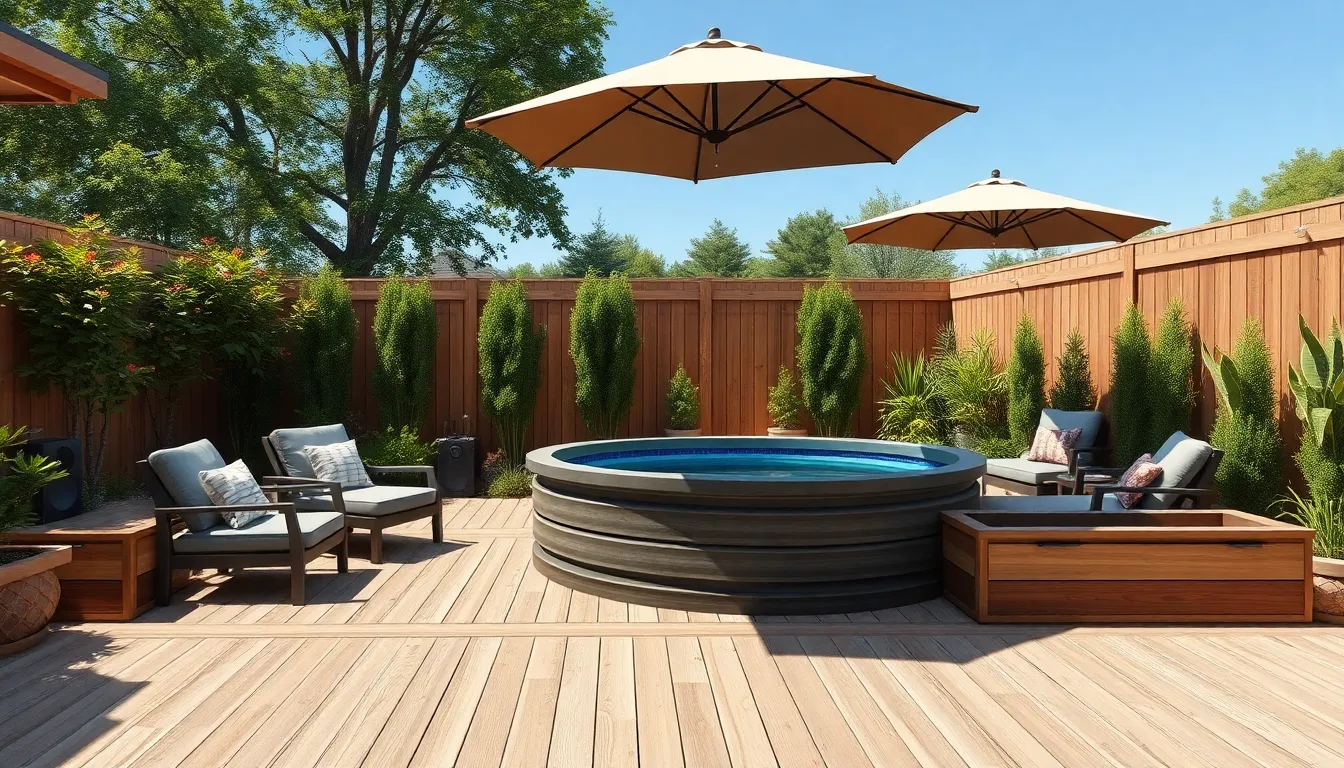
Transform your stock tank pool into the ultimate backyard destination by focusing on comfort and entertainment features. Strategic additions can turn a simple pool setup into an inviting social hub that rivals traditional pool installations.
Design Outdoor Seating Zones
Building decks around your stock tank pool provides ample space for lounging, sunbathing, and socializing with family and friends. Wood slat back walls offer versatility by supporting greenery displays, towel storage, and enhanced visual appeal throughout the entertainment area.
Positioning chic lounge chairs or custom benches near the pool creates dedicated relaxation zones where guests can comfortably enjoy the poolside atmosphere. We recommend spacing seating at least 3 feet from the pool’s edge to allow safe movement and easy access.
Consider incorporating built-in storage benches that serve dual purposes by providing seating while hiding pool maintenance supplies, towels, and recreational equipment. These functional pieces maximize your deck space efficiency.
Add weather-resistant cushions and throw pillows in coordinating colors to enhance comfort levels and create visual cohesion across your entertainment zone. Outdoor fabrics resist fading and moisture while maintaining their appearance through multiple seasons.
Add Shade Structures and Umbrellas
Patio umbrellas and standalone umbrella systems complement stock tank pools by delivering essential sun protection and visual enhancement to your entertainment space. These structures create comfortable microclimates where guests can escape direct sunlight.
Installing pergolas or small canopies around seating areas establishes cozy outdoor rooms that feel separate from the main pool zone. Wooden pergolas work particularly well with stock tank setups because they maintain the rustic aesthetic while providing substantial shade coverage.
Retractable awnings offer flexible shade answers that adjust based on weather conditions and time of day. We’ve found motorized versions especially convenient for quick adjustments during pool gatherings.
Shade sails create modern, sculptural elements that stretch between anchor points to cover large areas efficiently. These triangular or rectangular fabric panels cost less than permanent structures while delivering comparable sun protection.
Install Outdoor Speakers and Entertainment
Integrating outdoor speakers into your poolside setup adds an essential entertainment dimension that transforms casual swimming into memorable gatherings. Weatherproof speaker systems withstand moisture exposure while delivering quality audio performance.
Bluetooth-enabled speakers offer wireless convenience and easy connectivity to smartphones, tablets, and other devices without running cables across your deck area. Many models feature rechargeable batteries that eliminate the need for permanent electrical connections.
Combining speakers with string lights or decorative lighting elevates the ambiance for evening entertainment and extends your pool’s usable hours. LED strip lights around deck perimeters create subtle illumination that highlights seating zones.
Consider installing outdoor televisions or projector systems for larger entertainment areas where viewing sports events or movies enhances the poolside experience. Weatherproof enclosures protect electronic equipment from moisture and temperature fluctuations.
Smart home integration allows voice control of music, lighting, and other entertainment features through systems like Alexa or Google Home, creating seamless operation during pool parties and relaxation sessions.
Budget-Friendly DIY Installation Tips
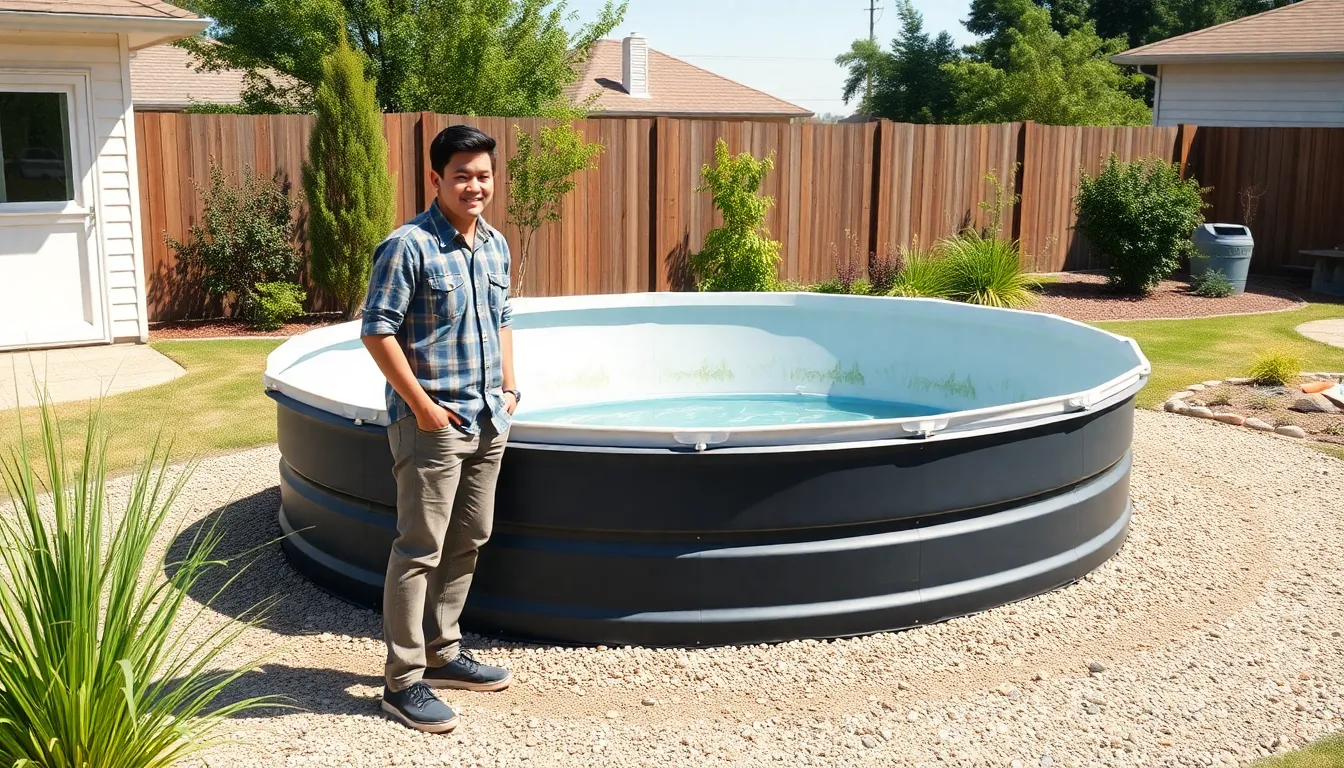
Building your own stock tank pool doesn’t have to expensive when you follow smart installation strategies. We’ll guide you through cost-effective approaches that maximize value while ensuring professional results.
Prepare the Ground and Foundation
Level the ground thoroughly before positioning your stock tank to prevent structural stress and uneven water distribution. We recommend digging out high spots and filling low areas with dirt or gravel to create a perfectly flat surface.
Compact the soil and gravel using a hand tamper or power tamper to prevent settling after you fill the pool. This crucial step ensures your foundation remains stable throughout the pool’s lifespan.
Test your stock tank for leaks by filling it completely with water before installation. We suggest checking all seams carefully and using silicone sealant applied from inside the tank to fix any leaks you discover.
Avoid placing your pool on soft or uneven ground as this can cause warping or permanent damage to the tank structure. A stable, firm foundation protects your investment and prevents costly repairs down the road.
Handle Plumbing Connections Safely
Drill inlet and outlet holes carefully in your stock tank walls using appropriate drilling tools for clean, precise openings. We recommend measuring twice and drilling once to avoid mistakes that could compromise your tank’s integrity.
Install plunger valves on both inlet and outlet holes to control water flow during maintenance and cleaning sessions. These valves give you complete control over your pool’s circulation system.
Connect your pool pump correctly by attaching the inlet hose to the pump’s wider intake and the outlet hose to the smaller discharge port. This proper connection ensures optimal water circulation and filtration efficiency.
Fill your pool completely before turning on the pump to prevent damage to the motor and impeller. We always ensure water covers both inlet and outlet connections before powering up any equipment.
Run electrical cords safely using outdoor rated extension cords positioned away from walkways and water sources. Proper electrical setup prevents accidents and protects your equipment from weather damage.
Avoid Common Installation Mistakes
Never skip ground leveling as an unlevel surface creates structural stress that can crack or warp your tank over time. We’ve seen too many installations fail because owners rushed this critical foundation step.
Don’t ignore leak testing before installation since discovering leaks after setup wastes time and potentially damages your landscaping. Testing beforehand saves money and prevents frustration later.
Avoid starting your pump prematurely without sufficient water covering the inlet and outlet connections. Running a dry pump can burn out the motor and require expensive replacement.
Don’t use inadequate sealing around holes and valve connections as poor sealing leads to persistent leaks. We recommend applying silicone sealant generously from inside the tank for the most durable seal.
Never compromise on electrical safety by using indoor extension cords or leaving connections exposed to moisture. Proper electrical setup protects both your family and your equipment investment.
Maintain Your Stock Tank Pool for Longevity
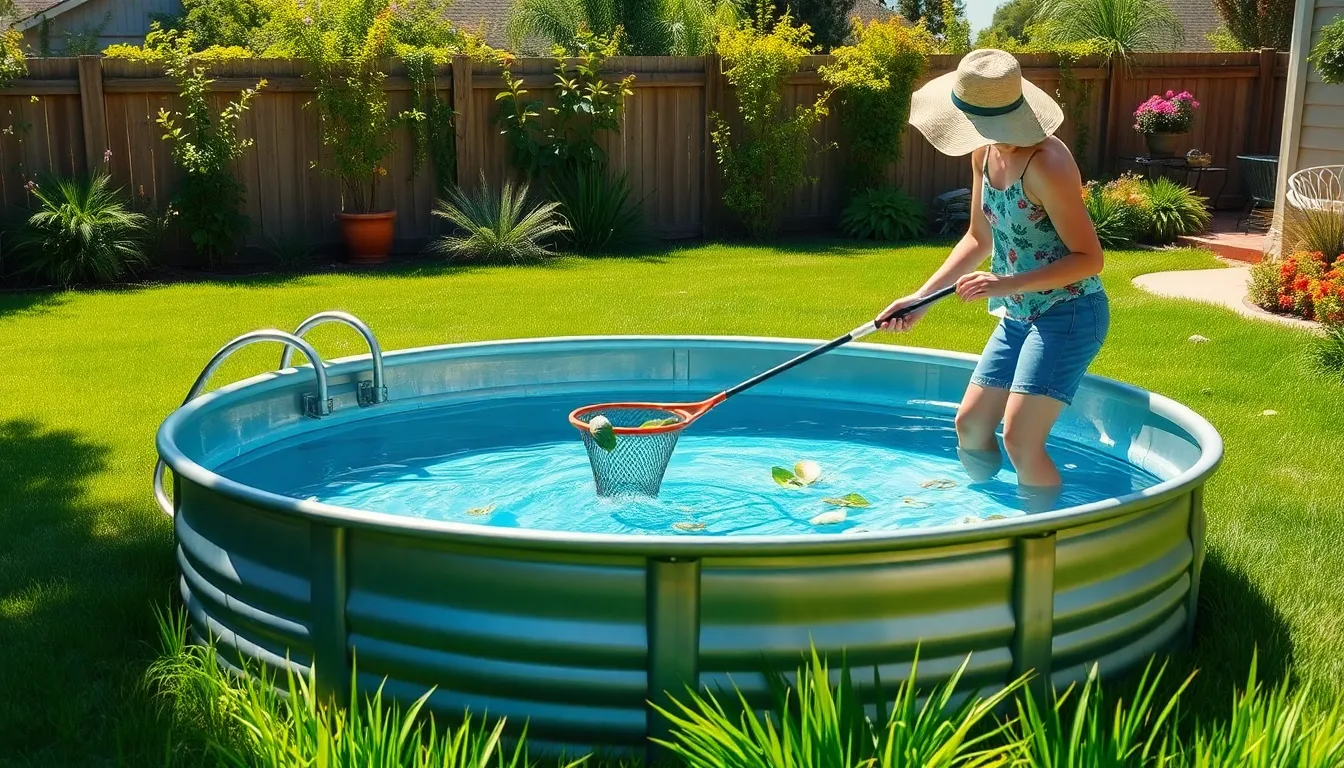
Proper maintenance is the key to keeping your stock tank pool functional and enjoyable for many seasons. We’ll help you establish effective routines that prevent common issues and protect your investment.
Establish Regular Cleaning Routines
Daily skimming removes leaves and floating debris from the water surface before they sink and become harder to clean. We recommend using a pool skimmer net each morning to maintain crystal clear water.
Weekly vacuuming eliminates debris that settles on the bottom of your tank. Our experience shows that regular vacuuming prevents buildup that can cloud the water and strain your filtration system.
Brushing pool walls weekly prevents slimy algae growth that makes surfaces slippery and unsanitary. We suggest using a pool brush specifically designed for metal surfaces to avoid scratching.
Filter maintenance requires frequent attention since stock tank pools rely heavily on proper filtration. Cleaning or replacing filters every 1-2 weeks keeps water circulation efficient and clear.
Chemical balance testing should happen 2-3 times per week to maintain pH levels between 7.2-7.6 and alkalinity between 80-120 ppm. We recommend using test strips for quick and accurate readings.
Chlorine tablet additions maintain consistent sanitizer levels that prevent bacteria growth and algae formation. Adding tablets to a floating dispenser ensures steady chemical distribution throughout your pool.
Shock treatments become necessary when water appears cloudy or develops a green tint. We apply pool shock during evening hours to maximize effectiveness and restore water clarity overnight.
Prevent Rust and Corrosion Issues
Balanced water chemistry serves as your first line of defense against metal corrosion. Maintaining proper pH and alkalinity levels minimizes the chemical reactions that cause rust formation.
Thorough pre-use cleaning removes manufacturing residue and contaminants that accelerate corrosion. We scrub new tanks with mild detergent or vinegar solution before the first fill.
Regular debris removal prevents organic matter from trapping moisture against metal surfaces. Leaves and grass clippings create perfect conditions for rust to develop if left unattended.
Galvanized steel selection provides natural rust resistance when choosing livestock-grade tanks. We always verify that tanks are designed for water use rather than feed storage.
Protective coating application becomes an option when rust spots appear even though proper maintenance. Pool-safe paints and coatings can extend tank life when applied correctly to clean, dry surfaces.
Moisture management during off-season storage prevents rust formation in hidden areas. Completely drying your tank before winter storage eliminates the moisture that feeds corrosion.
Winterize Your Pool Properly
Partial or complete draining depends on your local climate and freeze risk. We recommend complete drainage in areas where temperatures drop below 20°F for extended periods.
Equipment removal protects pumps, filters, and heaters from freeze damage. Storing these components indoors extends their lifespan and prevents costly replacements.
Thorough cleaning before winterization removes algae and debris that can cause staining or damage during storage. We scrub all surfaces and rinse completely before covering.
Secure covering keeps debris out and reduces spring startup maintenance. Pool covers designed for round tanks provide the best protection against wind and weather.
Pump and filter storage requires proper cleaning and drying before indoor storage. We drain all water from equipment and store in temperature-controlled areas to prevent component damage.
Chemical balance adjustment before closing helps prevent algae growth in remaining water. Slightly higher chlorine levels protect against organic growth during dormant periods.
Conclusion
We’ve covered everything you need to transform your backyard with a stock tank pool – from choosing the right size and installing proper filtration to creating stunning decks and entertainment areas. These versatile pools offer endless customization possibilities that can fit any budget or style preference.
The beauty of stock tank pools lies in their simplicity and potential. Whether you’re looking for a quick summer cooling solution or planning a complete backyard transformation with heating systems and entertainment features, these pools deliver exceptional value.
With proper maintenance and thoughtful enhancements, your stock tank pool will provide years of enjoyment while adding a unique focal point to your outdoor space. We’re confident these ideas will help you create the perfect backyard oasis that matches your vision and lifestyle.
Frequently Asked Questions
What is a stock tank pool and why are they popular?
A stock tank pool is an affordable alternative to traditional backyard pools, made from galvanized steel tanks originally designed for livestock. They’ve gained popularity due to their cost-effectiveness, quick installation, and customization options. These pools typically cost a fraction of traditional pools and can be set up in days rather than months, making them perfect for homeowners wanting immediate summer relief.
What sizes are available for stock tank pools?
Stock tank pools range from 6 to 11 feet in diameter with depths of 18 to 24 inches. The most popular sizes are 8-foot and 10-foot diameter tanks. When selecting size, measure your yard space and ensure adequate clearance around the tank for maintenance and safety. Consider how many people will use it and your available space for the best fit.
Do I need special equipment to maintain water quality?
Yes, proper filtration and circulation are essential. You’ll need a pool pump (Intex filter pumps are recommended for affordability), running 4-6 hours daily. Regular maintenance includes testing water chemistry, adding sanitizers, skimming debris, and using pool covers when not in use. This equipment prevents stagnation and keeps water clean and safe for swimming.
What kind of foundation do stock tank pools need?
Stock tank pools require a level, compacted base to prevent structural issues. A compacted gravel foundation is recommended, with the ground properly leveled before installation. Larger tanks may need professional installation due to weight requirements. Poor foundation preparation is a common mistake that can lead to uneven settling and potential damage to the tank structure.
Can I heat my stock tank pool for year-round use?
Yes, several heating options are available. Solar heating systems are eco-friendly and cost-effective, electric heaters provide consistent temperature control, and wood-fired conversions create a rustic hot tub experience. Each method has different benefits and installation requirements, allowing you to choose based on your climate, budget, and desired level of temperature control.
How can I customize and decorate my stock tank pool?
Customization options include protective coatings to prevent rust, decorative tiles or mosaic accents, and custom paint colors and patterns. You can build wooden or composite decking around the pool, add built-in seating, install lighting (LED string lights or underwater options), and create landscaping with strategic plantings and decorative stone features for a complete backyard oasis.
What safety features should I include?
Essential safety features include safe entry points like dual-sided steps or removable ladders, pool covers for debris protection and safety, rim padding to prevent injuries, and emergency equipment such as reaching poles and life rings. Pool alarms that detect unexpected water movement are also recommended, especially for families with children or pets.
How much maintenance do stock tank pools require?
Regular maintenance includes daily skimming, weekly vacuuming and brushing to prevent algae, and ongoing filter maintenance. Test water chemistry regularly and maintain proper chemical balance. For longevity, focus on rust prevention through balanced water chemistry and proper winterization during colder months. This routine maintenance ensures safe swimming conditions and extends the pool’s lifespan significantly.

